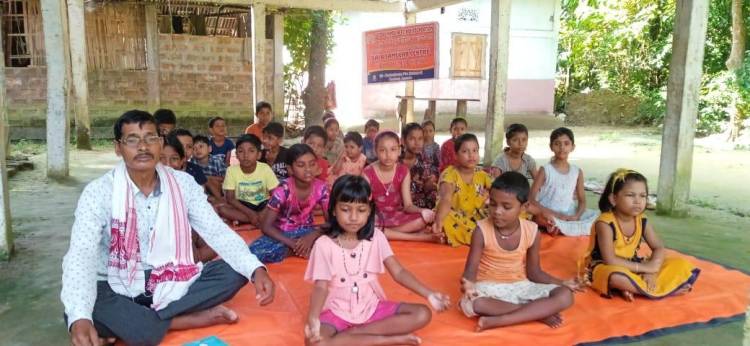[GHHF] Bala Samskar Students in Assam learned about Rana Pratap Singh as a brave soldier and was called “India’s first freedom fighter.”
 Maharana Pratap was born on May 9, 1540, in Kumbhalgarh Fort to Jaiwanti Bai and Udai Singh II. He had three younger brothers and two stepsisters. His father, Udai Singh II, was the king of Mewar and his capital was Chittor.
Maharana Pratap was born on May 9, 1540, in Kumbhalgarh Fort to Jaiwanti Bai and Udai Singh II. He had three younger brothers and two stepsisters. His father, Udai Singh II, was the king of Mewar and his capital was Chittor.
When Pratap succeeded his father to the throne, his brother Jagmal Singh, who was nominated as the Crown Prince by Udai Singh swore revenge and joined the Mughal army. The Mughal king Akbar rewarded him with the town of Jahazpur for the help he rendered.
When the Rajputs left Chittor, Mughals took control of the place, but their attempts to annex the kingdom of Mewar remained unsuccessful. A number of envoys were sent by Akbar trying to negotiate with Pratap to strike an alliance, but that did not work. Six diplomatic missions were sent by Akbar in 1573 but were turned down by Maharana Pratap. The last of these missions was led by Akbar’s brother-in-law Raja Man Singh. When the efforts of signing a peace treaty failed, Akbar made up his mind to face the mighty Mughal army.
Maharana Pratap is often considered to be ‘India’s first freedom fighter,’ as he did not surrender to the Mughal armies led by Akbar. A historic site dedicated to Maharana Pratap, Maharana Pratap Memorial, is situated at the top of Moti Magri, Pearl Hill in Udaipur. It was built by Maharana Bhagwat Singh Mewar and showcases a life-sized bronze statue of the gallant warrior riding his horse ‘Chetak.’
The great warrior left for the heavenly abode on 29th January 1597, at the age of 56, because of injuries sustained during his incessant struggle against the Mughal Empire. His eldest son, Amar Singh I, succeeded him to the throne of Mewar.
• Maharana Pratap was seven feet and five inches tall and weighed 110 kgs.
• The weight of the armor of his chest was 72 kgs and his spear weighed 81 kgs.
• The total weight of Maharana Pratap’s shield, spear, two swords and armor was around 208kgs.
• Maharana Pratap and his forces were continuously in war with the Mughals which lead to financial crises and he was left with no money to support his forces. It was then that Bhama Shah, Maharana Pratap’s minister, financially aided Pratap with which he was able to support and sustain his army for the next twelve years.
• Maharana Pratap was very efficient in using guerrilla warfare tactics.
• He had a very faithful horse named Chetak, who was also Maharana’s favorite. Chetak became immortal to save Rana Pratap in the Battle of Haldighati.
• Rana Pratap spent a major part of his life, especially his childhood in the forest of Aravallis. Pratap was called Keeka by the tribals; he is also revered as Rana Keeka.
• It is a well-known fact that Pratap loved his horse Chetak, but very few know that Chetak had blue eyes. It is because of this that Maharana Pratap was also revered to as ‘Rider of the Blue Horse.’
After 1587, Akbar relinquished his obsessive pursuit of Maharana Pratap and took his battles into Punjab and India's Northwest Frontier. Thus, for the last ten years of his life, Maharana Pratap ruled in relative peace and eventually freed most of Mewar, including Udaipur and Kumbhalgarh, but not Chittor. Bhagwat Singh Mewar: 'Maharana Pratap Singh (was) called the light and life of the Hindu community. There were times when he and his family and children ate bread made of grass.' Maharana Pratap became a patron of the Arts. During his reign Padmavat Charita and the poems of Dursa Ahada were written. Palaces at Ubheshwar, Kamal Nath and Chavand bear testimony to his love of architecture. These buildings, built in the dense hilly forest have walls adorned with military-style architecture. But Pratap's broken spirit overpowered him in the twilight of his years. His last moments were an appropriate commentary on his life, when he swore his successor, Crown Prince Amar Singh to eternal conflict against the foes of his country's independence. Maharana Pratap was never able to win back Chittor, but he never gave up fighting to win it back.
In January 1597, Rana Pratap Singh I, Mewar's greatest hero, was seriously injured in a hunting accident. He left his body at Chavand, aged 56, on January 29, 1597. He died fighting for his nation, for his people, and most importantly for his honor.
Your donations are appreciated.
By Zelle: ghhfusaorg@gmail.com
PayPal: savetemples.org
By Check: Or you can send a check payable to GHHF, 14726 Harmony Lane, Frisco, TX 75035.
It is tax-deductible.
By Rupees: call 601-918-7111; +91 83096 43979





















 Urgent support needed for Bangladesh Hindus
Urgent support needed for Bangladesh Hindus 







